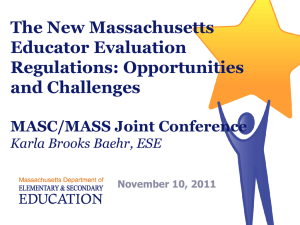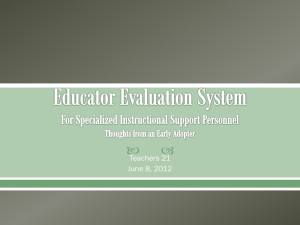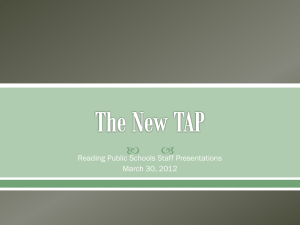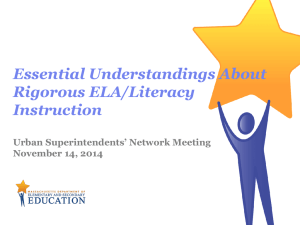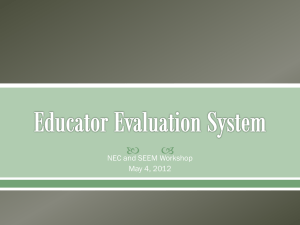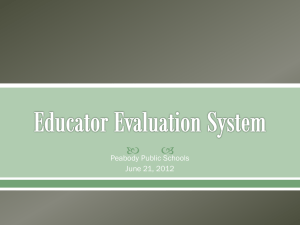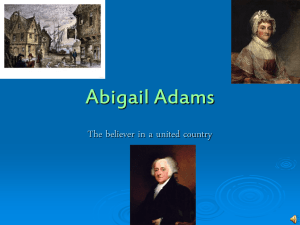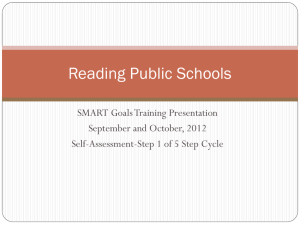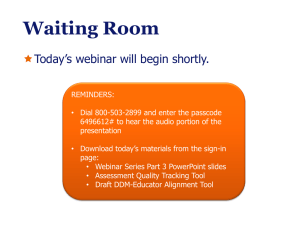The New MA Educator Evaluation Framework:
advertisement
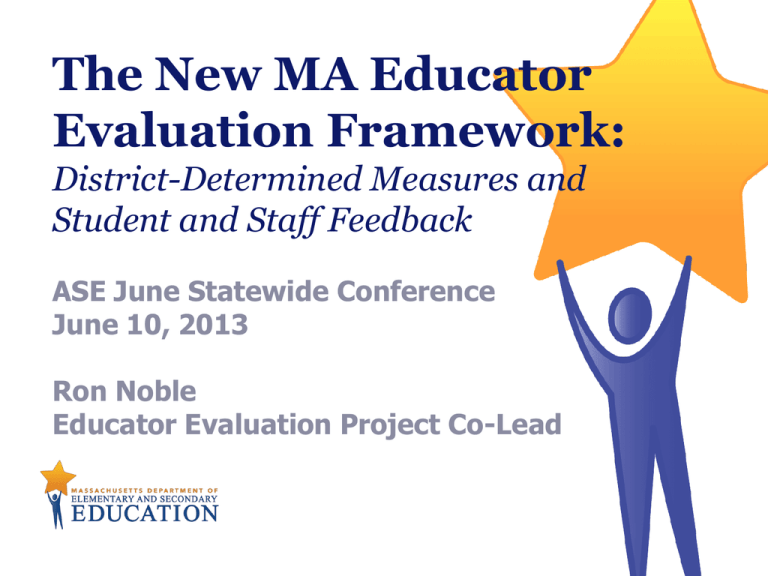
The New MA Educator Evaluation Framework: District-Determined Measures and Student and Staff Feedback ASE June Statewide Conference June 10, 2013 Ron Noble Educator Evaluation Project Co-Lead Agenda Setting the Stage 2012-2013 Implementation Lessons Learned On the Horizon District-Determined Measures Student and Staff Feedback Q&A 2 Massachusetts Department of Elementary & Secondary Education Setting the Stage When policy and practice must move faster than research and development, where do you begin? ESE Philosophy: Don’t let perfection be the enemy of good: the work is too important to delay. Understand this is just the beginning: we will be able to do this work with increasing sophistication each year Phased-in implementation: take advantage of emerging research, resources, and feedback from the field. Massachusetts Department of Elementary & Secondary Education 3 Are variations in Questions for contributions measurable? • • • Policy Makers: How should we the MCAS Attribution: “Whenuse crediting teachers for student learning, how should the individual contributionsAlternate of teachers acting in a coteaching or consultant role be determined? Assessment? How do we differentiate Assessments: “How can the contributions to student achievement be accurately without measured for teachers instructing special populations for creating which alternative standards and/or assessments are used?” “two systems”? Educator differentiation: “Are the key features of teacher effectiveness for specialized personnel, such as special education teachers different… and should those unique features lead to additional or different content on observation Who IS the protocols, student growth assessments, or alternative instruments?” evaluator? • Evaluator training: “When rating special education teachers…using an observation protocol or alternative instrument, what special training, if any, do evaluators need?” Holdheide, L.R., Goe, L., & Reschly, D.J.. (2010) Challenges in Evaluating Special Education Teachers and English Language Learner Specialists. National Comprehensive Center for Teacher Quality. Massachusetts Department of Elementary & Secondary Education 4 Implementation Timeline June 2011 MA Board of Education passed new educator evaluation regulations September 2011 Implementation began in 34 “Level 4” schools, 11 “Early Adopter” districts and 4 Special Education Collaboratives January 2012 MA Department of Elementary and Secondary Education (ESE) published the MA Model System for Educator Evaluation September 2012 RTTT districts began implementation with at least 50% of educators. September 2013 •RTTT districts begin implementation with remaining educators. •Non-RTTT districts begin implementation with at least 50% of educators. 2013-2014 school year •All districts pilot District-Determined Measures. •Selected districts pilot student and staff surveys 2014-2015 school year •All districts implement District-Determined Measures. •All districts implement student and staff surveys June 2016 •District determine Student Impact Ratings for all educators. Massachusetts Department of Elementary & Secondary Education 5 2012-2013 Implementation 234 Race to the Top Districts At least 50% of educators Summative Performance Rating only 5-Step Evaluation Cycle June data reporting (EPIMS) 6 data elements: 1. 2. 3. 4. 5. 6. Rating on Standard I Rating on Standard II Rating on Standard III Rating on Standard IV Overall Summative Performance Rating Professional Teacher Status (Y/N) Massachusetts Department of Elementary & Secondary Education 6 5 Step Evaluation Cycle Every educator is an active participant in an evaluation Process promotes collaboration and continuous learning Process applies to all educators 7 Massachusetts Department of Elementary & Secondary Education Summative Rating Summative Performance Rating Exemplary Self-Directed Growth Plan Proficient Needs Improvement Directed Growth Plan Unsatisfactory Improvement Plan 8 Massachusetts Department of Elementary & Secondary Education Educator Evaluation Spring Convening: Connecting Policy, Practice, and Practitioners May 29, 2013 Over 700 participants from district teams (RTTT and non-RTTT) and educator preparation programs Key messages: Integrate with other key district initiatives Opportunity to strengthen labor-management relations Albeit difficult, it’s the right work Massachusetts Department of Elementary & Secondary Education 9 On the Horizon District-Determined Measures Student and Staff Feedback 10 Massachusetts Department of Elementary & Secondary Education District-Determined Measures: Key Terms Student Impact Rating – a rating of high, moderate, or low for an educator’s impact on student learning District-Determined Measures – measures of student learning, growth, and achievement that will inform an educator’s Student Impact Rating Massachusetts Department of Elementary & Secondary Education 11 Student Impact Rating Regulations Evaluators must assign a rating based on trends (at least 2 years) and patterns (at least 2 measures) Options – 603 CMR 35.07(1)(a)(3-5) Statewide growth measure(s)* District-determined Measure(s) of student learning comparable across grade or subject district-wide. For educators whose primary role is not as a classroom teacher, the appropriate measures of the educator's contribution to student learning, growth, and achievement set by the district. Massachusetts Department of Elementary & Secondary Education 12 Summative Rating Two Ratings Exemplary 1-yr Self-Directed Self-Directed 2-yr Self-Directed Growth Plan Growth Plan Growth Plan Proficient Needs Improvement Directed Growth Plan Unsatisfatory Improvement Plan Low Moderate High Rating of Impact on Student Learning Massachusetts Department of Elementary & Secondary Education 13 Student Impact Rating Regulations Why focus on growth? Level playing field Fairness Achievement measures may be acceptable when the district judges them to be the most appropriate/feasible measure for certain educators 14 Massachusetts Department of Elementary & Secondary Education Revised Implementation Timeline Commissioner’s Memo - 4/12/13 2013-2014 – districts pilot and identify DDMs 2014-2015 – districts implement DDMs and collect the first year of trend data 2015-2016 – districts collect the second year of trend data and issue Student Impact Ratings for all educators Districts positioned to accelerate the timeline should proceed as planned. Guidance and resources to support districts with the identification of DDMs are available here: http://www.doe.mass.edu/edeval/ddm/ Massachusetts Department of Elementary & Secondary Education 15 Revised Implementation Timeline Minimum Piloting Requirements Early grade (K-3) literacy Early (K-3) grade math Middle grade (5-8) math High school writing to text Traditionally non-tested grades and subjects (e.g., fine arts, music, physical education) If a district is unable to identify a DDM in the grades and subjects listed above, the district must pilot one of ESE’s exemplar DDMs to be released in summer 2013. Massachusetts Department of Elementary & Secondary Education 16 Recommended Steps for Districts Identify a team of administrators, teachers and specialists to focus and plan the district’s work on District-Determined Measures. Complete an inventory of existing assessments used in the district’s schools. Identify and coordinate with partners that have capacity to assist in the work of identifying and evaluating assessments that may serve as DistrictDetermined Measures. Quick Reference Guide: District-Determined Measures Massachusetts Department of Elementary & Secondary Education 17 17 ESE Supports WestEd is supporting ESE with next steps in implementing the Commonwealth’s Model System for Educator Evaluation Two broad categories of work Support development of anchor standards in almost 100 separate grades/subjects or courses Identification and evaluation of promising measures, tools, tests, rubrics Work to be completed by mid-August Massachusetts Department of Elementary & Secondary Education 18 ESE Supports Supplemental guidance on the selection of DDMs and the process of determining an Impact Rating DDM and Assessment Literacy Webinar Series (March – December) Technical Guide A (released in May 2013) focuses on selecting high quality assessments Includes Assessment Quality Checklist and Tracking Tool Technical Guide B (expected in August 2013) will focus on measuring growth. 19 Massachusetts Department of Elementary & Secondary Education ESE Supports Assessment Quality Checklist Tool General Information Grade and Subject or Course Potential DDM Name Potential DDM Source Type of Assessment Item Types Step #1: Evaluate Content Alignment Alignment Alignment to Curriculum Rigor Alignment to Intended Rigor 0 Total Score 0 % of Possible Score 0% Step #2: Evaluate Remaining Evidence of Assessment Quality Utility Utility & Feasibility Feasibility Assessment Components Reliability Validity Non-Bias Item Quality Describe the Process Used to Determine Ratings 0 Table of Test Specifications Administration Protocol Instrument Scoring Method Technical Documentation Reliability Evidence Collection Approach Reliability Evidence Quality Validity Evidence Collection Approach Validity Evidence Quality Gathered Evidence of Non-Bias Describe the Process Used to Determine Ratings 0 0 0 0 0 0 0 0 0 0 0 Range of Item Difficulties Positively Discriminating Items 0 0 0 No Floor/Ceiling Effects 0 Total Score 0 % of Possible Score 0% 20 Massachusetts Department of Elementary & Secondary Education DDMs: Request for Feedback Attribution: How can ESE best support districts in developing attribution policies related to the determination of Student Impact Ratings, particularly for coteachers, consulting teachers, and other scenarios where more than one teacher contributes to student learning, growth, and achievement? Movement of Students: Due to highly specialized and often changing needs, the population of children identified as needing special education services fluctuates annually, sometimes in significant amounts, and mostly in the elementary grades. This fluctuation means students move in and out of special education classes and may not receive special education instruction for an entire year. How should ESE recommend districts take student movement into account when determining special educators’ Student Impact Ratings? Selecting Assessments: What are some considerations ESE should be aware of when providing guidance on the selection of measures of student growth to be 21 21 used in the determination of special educators’ Student Impact Ratings? Please include specific examples of measures that would or would not be appropriate and why. Massachusetts Department of Elementary & Secondary Education Student and Staff Feedback Revised Implementation Timeline: Beginning in the 2014-2015 school year, districts will include student feedback in the evaluation of all educators and staff feedback in the evaluation of all administrators. During the 2013-2014 school year, ESE will work with districts to pilot/field test model survey instruments. Massachusetts Department of Elementary & Secondary Education 22 Multiple sources of evidence inform the summative rating 23 Massachusetts Department of Elementary & Secondary Education National Overview A growing number of states are currently using or preparing to use student surveys in educator evaluations Alaska Idaho Mississippi Arizona Kentucky New Jersey Colorado Maine New York Delaware Massachusetts North Carolina Georgia Michigan Hawaii Missouri Rhode Island Washington Massachusetts Department of Elementary & Secondary Education 24 Why Use Student Surveys in Educator Evaluations? Perception surveys round out a multiple measure evaluation system Research also finds student surveys are correlated with student achievement The Measures of Effective Teaching Project found students’ perceptions are reliable, stable, valid, and predictive Surveys may be the best gauge of student engagement When asked which measures are good or excellent at assessing teacher effectiveness, teachers reported District standardized tests (56 percent) Principal feedback (71 percent) 25 Students’ level of engagement (92 percent) Massachusetts Department of Elementary & Secondary Education What Students Say… MA’s State Student Advisory Council and six regional student advisory councils provide a unique feedback loop for students MA Student Advisory Council focus groups were overwhelmingly positive toward soliciting their input through student surveys MA students want to help teachers improve MA students are excited about the prospect of being surveyed for this purpose MA students offered thoughtful precautions about survey use: Use surveys for teacher goal-setting Consider making survey feedback visible only to teachers Provide 3rd party screeners of any open-ended questions 26 Massachusetts Department of Elementary & Secondary Education Surveys as a Form of Feedback Benefits of Surveys of Classroom/School Experiences Offers valuable insight from those with first-hand experience Empowers and engages survey recipients, sending a signal that their input is valued Comparatively inexpensive Considerations When Using Surveys of Classroom/School Experiences Students may lack cognitive ability or maturity Could become a popularity contest or “rate-yourteacher.com” Survey results could be misused by evaluators 27 Massachusetts Department of Elementary & Secondary Education National Perspective – Lessons Learned The more immediate the feedback the better The more flexibility for teachers to administer surveys when they wish the better Surveys for early grades and special populations require special attention To the extent that surveys are used for high stakes decisions at all, this should not happen until after they have been used effectively and reliably, and educators have grown comfortable with them, in a low stakes setting When used for formative purposes, surveys are generally seen as a good thing Massachusetts Department of Elementary & Secondary Education 28 Perspectives & Considerations Key areas for state or district consideration: 1. Determining survey samples 2. Timing of survey administration 3. Reporting of survey results 4. Using survey results in evaluations 5. Considerations for pre-readers, special education, and English Learners 29 Massachusetts Department of Elementary & Secondary Education Student and Staff Feedback: Request for Feedback Source of Evidence: In what way or ways should ESE recommend student and staff feedback be used as a source of additional evidence relevant to one or more Performance Standards? Accommodations: What types of arrangements are most appropriate for the special populations, i.e., pre-readers, students with limited English proficiency, and students with disabilities, so that their feedback can be taken into account as well? Data Collection Tools: In addition to perception surveys, what other types of data collection tools for capturing student feedback should ESE recommend and for what populations would these tools be most useful? 30 Massachusetts Department of Elementary & Secondary Education Additional Questions? Ron Noble – rnoble@doe.mass.edu or 781.338.3243 31 Massachusetts Department of Elementary & Secondary Education
